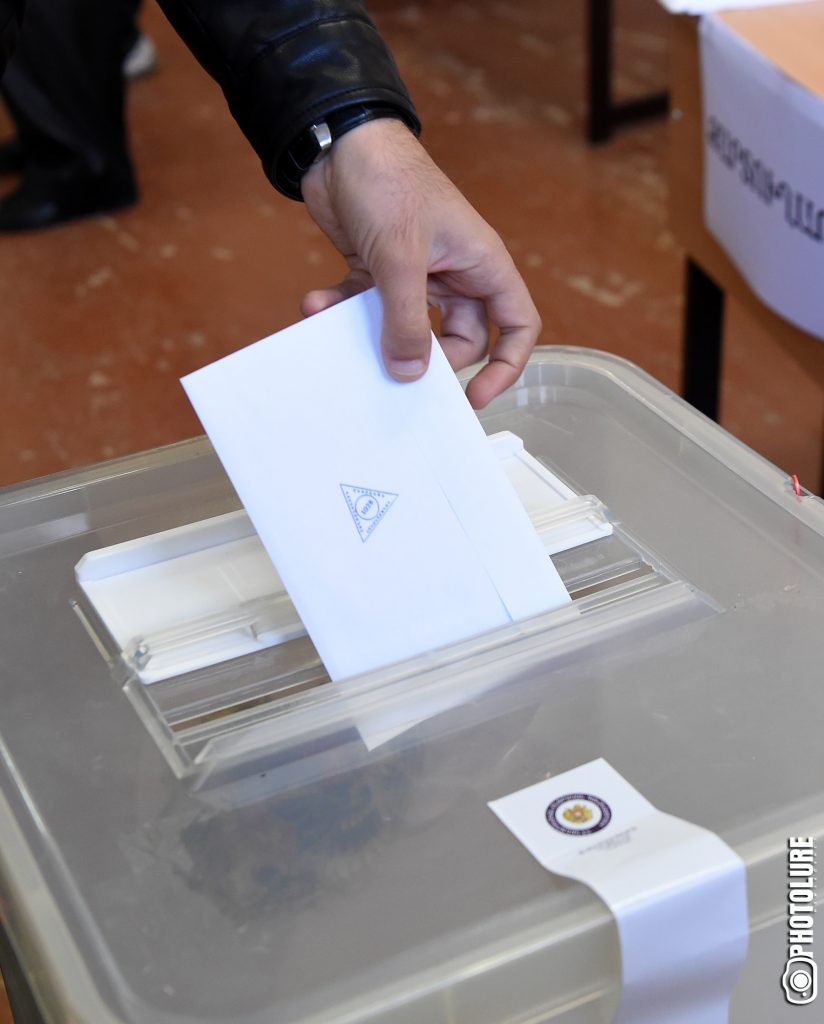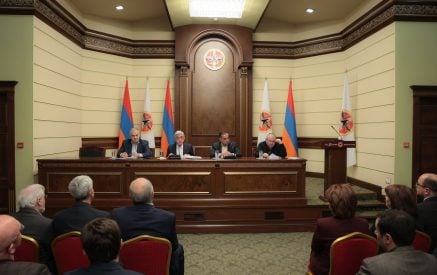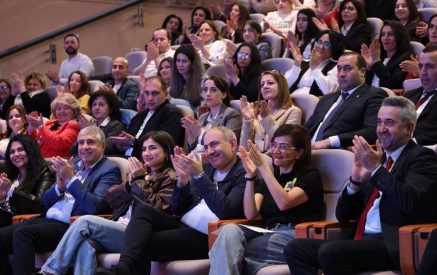On April 2, Armenia will go to the polls to elect a new National Assembly (Parliament).
A man casting his ballot in the 2012 Armenian Parliamentary elections (Photo: Photolure)
These elections will be the first conducted since the adoption of a new Constitution, granting unprecedented powers to those who are elected, while votes will be cast under rights and oversights provided by what is a new Electoral Code, adopted by most of the participating political parties and blocs.
This article is written to break through the jargon (you have probably recently heard terms like “rating-ayin” and “hamamasnakan”) and to provide a simplified explanation of the processes that will govern and determine the results of the upcoming elections in the Republic of Armenia.
These elections will be the first conducted under Armenia’s revised Constitution. What does this mean?
Read also
After the next presidential elections in 2018, the Presidency will become a ceremonial role rather than the current model, which lays a lot of the executive powers (including total say in Defense and Foreign policies) in the hands of the President;
Therefore, the National Assembly (Parliament) that is elected at these April 2017 elections will be the country’s main legislative force—it will form the cabinet whose members (Prime Minister and Ministers) cannot double as Members of Parliament (MPs). The Parliament (National Assembly) will be the highest body from which the power of authority derives;
The party, bloc (grouping of parties), or Coalition (grouping of parties and/or blocs post-vote count) that forms the majority in parliament will see their chosen persons as the country’s main executive body—namely the cabinet—headed by the Prime Minister. In times of peace, the cabinet as a collective body will lead the executive affairs of the country, while in times of war, the Prime Minister will take the responsibilities of commander in chief of the armed forces;
The rest of the Parties and Blocs who complete the minimum 101-seat parliament (parties require minimum 5% threshold and blocs require minimum 7% threshold) will form the opposition, who will collectively have a minimum 33% (and up to 46%) seat allocation in Parliament. If the opposition parties or blocs have not received 33% of the seats in Parliament, then they will be allocated further seats to reach 33%, thus increasing the total number of seats of the parliament from 101;
The opposition will therefore be able to hold the government to account on all key decisions through features which do not exist in the current political system of Armenia (e.g. their minimum 1/3rd voice, their ability to form key oversight/ad-hoc enquiry committees with only 25% of the parliament’s votes, as well as their rights to have members in permanent oversight bodies, etc.);
With only parties and blocs able to participate in the elections (i.e. no individuals can participate), and the elimination of the current semi-Presidential model, the new Constitution is designed to convert the Armenian political landscape to one focused on collectives (parties or blocs) rather than personalities;
With laws to be changed, the Judiciary will be fully independent of the executive, ensuring the independent functioning of, and checks and balances between the three main branches of authority (legislative [parliament], executive [cabinet] and judicial [courts]);
A new Electoral Code was negotiated and adopted by all key political parties ahead of these elections, which eliminates vote-rigging through multiple-voting and election day violations through the introduction of electronic machines and live video feeds of voting stations, and means of greater oversight (including publishing the lists of those who actually participated in the voting) than ever before;
The new Electoral Code practically cannot and does not eliminate the possibility of vote buying and selling, which has been a feature in past elections, as such deals are done privately and usually consensually by the buyer and seller of said votes. Instead, participant Parties and Blocs are vocally calling on citizens to place a higher value on their votes, which will determine the future direction of Armenia and their livelihoods.
And how will MPs be elected to the National Assembly (Parliament) on election day?
Each participating political party or bloc has registered with the Central Electoral Commission a list of all of its candidates—this includes a main list of their primary candidates and lists of up to 15 candidates in each of the 13 electoral districts in Armenia;
Citizens have the option (voting is not mandatory in Armenia) to vote in their registered electoral district on election day;
When they visit their voting station/election booth, they will be handed nine voting cards/ballots (one for each of the participating parties and blocs), and in the private voting booth, they will choose the voting card of the party or bloc they wish to vote for and place it in an envelope (they will throw the remaining eight ballots in the garbage bin in the private booth). This will confirm the political party they are choosing to give their vote to (e.g. if they place the card of the Yelk bloc in the envelope, it means they have voted for the Yelk bloc);
This Voting Card will also detail names of the candidates within their electoral district that their chosen party or bloc has put up as their local choices (e.g. if they have picked up the Armenian Revolutionary Federation (ARF) card in the district of Yerevan 1, they will see the 15 candidates put up for the Yerevan 1 district by the ARF). Using the square boxes beside each name, they will vote for their favorite (single) candidate from among the list;
The parties and blocs that are successful in entering Parliament will be represented by 50% from their main list and 50% from the regional lists, based on the d’Hondt Method. For example, if the Republican Party (RPA) ends up with 50 seats in the new Parliament, 25 of those seats will be occupied by the top persons on their main candidates list, and the other 25 will be the individuals from their regional electorate lists, selected based on the d’Hondt Method of selection, which is designed to maximize the possibility of representation from all districts;
If any participating party or bloc achieves a minimum of 54% of the vote, they will be eligible to form government in their own right and their chosen individual will become the Prime Minister of Armenia. If any participating party or bloc receives more than 50%+1, but less than 54% of the popular vote, they will be granted further seats (bonus), to reach the 54% of seats, thus the number of seats in the parliament would increase from 101;
If no party or bloc achieves a minimum of 50%+1 of the vote, they will be given an opportunity to negotiate with other parties or blocs to form a Coalition government. A maximum of three parties or blocs can form a Coalition government, and the Coalition government must be formed only by necessity of votes to cross the 54% threshold;
If no government can be formed after this negotiation, a second round of voting will ensue featuring only the top two ranking parties or blocs participating in the run-off to form government. The other parties and blocs, which do not participate in the second round, will maintain the number of seats they won, but not the percentage of seats in the parliament because the winning party or bloc in the second round will receive 54% of the seats, thus increasing the total number of seats of parliament from 101;
For the first time in the Armenia’s history, national minorities (Yezidis, Russians, Assyrians and Kurds) will have representatives in the parliament. The national minority candidates of the winning party or bloc (who have been registered as nominees by the participating parties and blocs) will be elected as representatives of the national minorities. The four national minority representatives will have seats above the 101+ seats in the parliament, and their voting rights will be restricted to issues of relevance.
Who are the nine parties and blocs that have registered to participate in the upcoming elections?
The ruling Republican Party (RPA);
Businessman Gagik Tsarukyan’s bloc, led by his Prosperous Armenia Party (PAP);
The Ohanyan-Raffi-Oskanian bloc, formed by prominent former ministers in past governments, Seyran Ohanyan, Raffi Hovhannisian, and Vartan Oskanian;
Yelk (Way Out) bloc, led by opposition MPs from the Bright Armenia (Lusavor Hayasran), Civil Contract (Kaghatsiakan Paymanagir), and Republic Parties (Hanrapetutyun);
Armenia’s first President Levon Ter-Petrosyan is leading a bloc with the People’s Party of Armenia, as head of his Armenian National Congress Party;
The Armenian Revolutionary Federation (ARF);
The Armenian Revival Party (formerly the Orinats Yerkir Party);
The Armenian Communist Party; and
The Free Democrats.
Official campaigning for the elections begins on March 5. Parties and blocs have already begun revealing their mottos, beliefs, and programs, which will be the subject of much commentary in the lead-up to the polls, including by this author in an upcoming article.























































